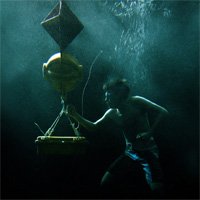Aug 11 2009
A picture of the moment at which a vehicle which photographs deep-sea life was lowered into the murky depths for the first time has won this year's photography competition at Cambridge University's Department of Engineering.

The image, called Project Pebble, shows an innovative, ultra-low-cost deep-sea photographic vessel while undergoing trials in test tanks. The device, which cost £1,800 to build, is 10 times cheaper than comparable deep-sea craft.
It is part of an ongoing project which it is hoped will reduce the cost to less than £1,000, making the normally expensive pursuit of deep-sea photography more affordable than ever before.
The image was one of a variety of outstanding pictures entered into the 6th annual photography competition. The contest aims to uncover beautiful, fascinating and intriguing images from the world of engineering.
The subjects covered by the entries ranged from the deep-sea endeavours of Project Pebble, to the sky-high ambition of the famous "Teddies In Space" project, which received worldwide attention when students from Cambridge University Spaceflight sent four teddy-bears 30,085 metres above sea level. Other entrants produced images of minute materials, such as microscopic zinc oxide crystals, unseen to the naked eye. The pictures can be taken by any staff or students in the Department of Engineering and must represent an aspect of their work.
The second prize went to Synapse, a micrograph taken through a scanning electron microscope by researchers Ivan Minev and Rami Louca as part of an ongoing research project which aims to develop flexible electronics.
Third place went to Rumble - a series of stills from a video of an aero-gas turbine burner flame during tests on a low-nitrogen oxide lean direct injection burner. The technology could ultimately be used to reduce aircraft pollutant emissions.
The competition was sponsored by Nokia and judged by a panel of senior academics from within the Department, comprising Roberto Cipolla, Professor of Information Engineering, Allan McRobie, Reader in the Structures Group, and Philip Guildford, Director of Research.
"Our students have really pushed the boundaries with this year's competition," Philip Guildford said. "It is inspiring that they can create such beautiful art from their brilliant engineering."
Other entries included images of icebergs in Argentina, debris on the launch pad following the launch of a rocket and vibrant colours from a device which combines liquid crystals and carbon nanotubes. For more information or to visit the online gallery, click on the links to the right of this page.